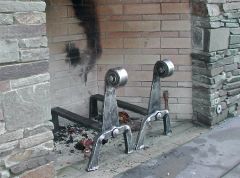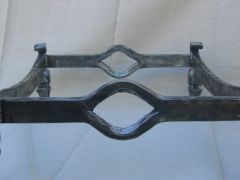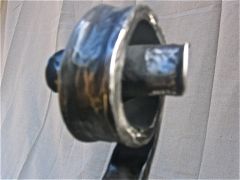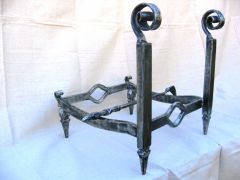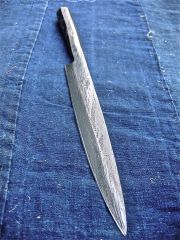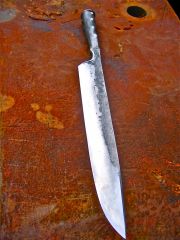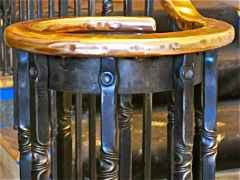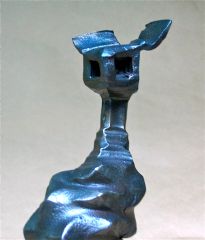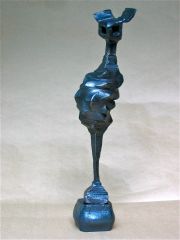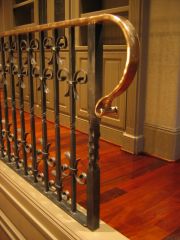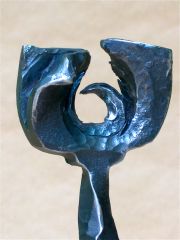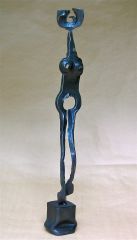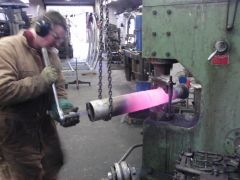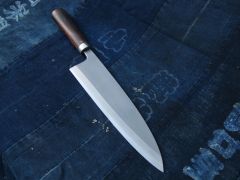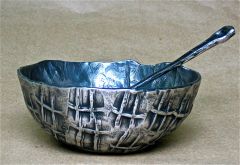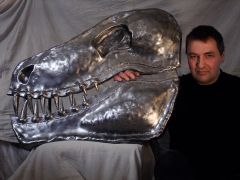-
Posts
28 -
Joined
-
Last visited
Content Type
Profiles
Forums
Articles
Gallery
Downloads
Events
Everything posted by kalevra
-
-
- forged stainless
- andirons
-
(and 1 more)
Tagged with:
-
-
- forged stainless
- andirons
-
(and 1 more)
Tagged with:
-
-
- forged stainless
- andirons
-
(and 1 more)
Tagged with:
-
-
-
thanks! silicone bronze forges readily, but requires very careful heating, as it crumbles when heated much beyond dark red. as long as one stays in this range, it is easily shaped. i have forged a lot of this stuff -- usually forging 1.5" round to a flat for handrails (it creates a very nice bar with rounded sides), or forging same to finials, or making large hinges from 3" round and 1/2" plate. you can also tig weld and mig weld it with ease. however, please be mindful that fumes and dust from this material can lead to metal fume fever, which is very, very unpleasant.
-
-
-
-
-

Zinc and Metal Fume fever
kalevra replied to Nick Esposito's topic in Zinc, galvanized, and coatings
i would like to mention that zinc is not the only hazardous metal that smiths can encounter in their work. i have worked extensively with silicone bonze, and careless handling can result is very unpleasant flue-like symptoms. it seems that one can be exposed to bronze/copper through polishing (dust inhalation), forging (scale dust inhalation), tig welding (fumes), and even extensive handling of freshly forged metal with bare hands (the scale rubs of readily and is absorbed through the skin). i don't know what, if any, the long-term effects are. the symptoms usually subside in a day or two. i suspect all metalworkers would benefit from chelation therapy at some point in their career. and remember to daily thank your liver and kidneys for getting rid of all the bad stuff we absorb in our work.- 29 replies
-
- zinc
- galvanized
-
(and 5 more)
Tagged with:
-
-
-
-
-
forging vertebrae for a t-rex sculpture from 2.5" stainless steel round bar.
-
here is a shot of a t-rex head i have been recently commissioned to make for a public park. the material is stainless steel -- 1/8" sheet for the skull, 3/4" round for the teeth, 1"x 2" for the jaws. the jaws were formed under a hydraulic press, and the 1/8" sheet hammered hot into a stump and/or dies using hand-hammers, pneumatic riveters, and a japanese sledgehammer. more shots to follow.
-

How is this hammer much different from a Hofi hammer
kalevra replied to Timothy Miller's topic in Hand Hammers
i think it's difficult to know, especially since there probably wasn't any standard, with great variety between both individual smiths & regions. if you look at videos of freddy habermann, for example, you will see that his hammer has some similarities to hofi's, and yet the two are also quite different. by the same token, during my apprenticeship in japan, i saw great variety of hammers, even though they were all used by knife/sword makers, and all fall within the category of "japanese cutlery hammer". some were decidedly superior to others. with hand tools, i find that apparently small differences in shape and weight translate into big differences in performance. a mercedes bentz and a trabant are both cars, both use an internal combustion engine, and both are (were?) made in germany, so on the surface, there is little difference. however, i know which one i would rather drive... -

How is this hammer much different from a Hofi hammer
kalevra replied to Timothy Miller's topic in Hand Hammers
hi there, thought i'd throw in my two cents' worth. been using hofi hammers for many years now, and by that i mean hammers actually coming out of hofi's shop. lots of copies out there, some quite inferior. it has to be understood that the hofi hammer's shape and proportions are not random -- they come with a very particular type use. a very well-known and skilled smith derided the hofi hammer in a conversation, stating that the head of the hammer was too short, causing him to scrape his knuckles on the anvil. it was immediately obvious from this remark that he simply didn't know who to use it properly -- it's the equivalent of complaining that the knife is at fault for you having sliced your finger. the difference in technique is subtle and takes practice as old habits have to be broken, yet the payback is well worth it -- you get much better accuracy, faster metal deformation, reduced fatigue and whole lot less stress on joints and ligaments. suffice to say that my wrist and elbow issues went away once i have adopted this method. i am sure that there are people out there who use similar grip and technique without even thinking about it - some of us have real smart bodies. i was introduced to the hofi hammer and forging method after i have already spent years apprenticed to various smiths in japan, and naturally assumed that i knew all the was to know about swinging a hammer. i was very, very wrong. so, again -- to derive full benefits from a hofi hammer one has to know, understand and use the particular forging technique. the hammers come with fairly sharp corners, and the individual smith is expected to grind & polish them to his specs. they can be cast of forged, doesn't really matter -- both work very well. at this point, i am not sure if hofi sells his hammers in the usa at all. i just came back from israel and got myself yet another one -- hofi has neat rows of finished hammers, cast and forged, waiting to go. in any case, a hammer made by hofi will always carry his name, and usually the date of manufacture, too. regarding other remarks about the hammer, making claims about the process: the forged hammers always have a slight hourglass eye (happens naturally when they are forged on a tapered mandrel from either side), and the shape is almost completed on the power hammer, not ground. naturally, the hammer is ground before heat-treatment and polished after. i was there during the manufacturing process, more than once, so i think i have grounds for saying so. it is not feasible to grind so many forged pieces to shape, especially since there is only one very simple simple belt grinder in hofi's shop. hope this was helpful for the discussion. -
hi there, been using hofi hammers for many years now, and by that i mean hammers actually coming out of hofi's shop. lots of copies out there, some quite inferior. it has to be understood that the hofi hammer's shape and proportions are not random -- they come with a very particular type use. a very well-known and skilled smith derided the hofi hammer in a conversation, stating that the head of the hammer was too short, causing him to scrape his knuckles on the anvil. it was immediately obvious from this remark that he simply didn't know who to use it properly -- it's the equivalent of complaining that the knife is at fault for you having sliced your finger. the difference in technique is subtle and takes practice as old habits have to be broken, yet the payback is well worth it -- you get much better accuracy, faster metal deformation, reduced fatigue and whole lot less stress on joints and ligaments. suffice to say that my wrist and elbow issues went away once i have adopted this method. i am sure that there are people out there who use similar grip and technique without even thinking about it - some of us have real smart bodies. i was introduced to the hofi hammer and forging method after i have already spent years apprenticed to various smiths in japan, and naturally assumed that i knew all the was to know about swinging a hammer. i was very, very wrong. so, again -- to derive full benefits from a hofi hammer one has to know, understand and use the particular forging technique. the hammers come with fairly sharp corners, and the individual smith is expected to grind & polish them to his specs. they can be cast of forged, doesn't really matter -- both work very well. at this point, i am not sure if hofi sells his hammers in the usa at all. i just came back from israel and got myself yet another one -- hofi has neat rows of finished hammers, cast and forged, waiting to go. in any case, a hammer made by hofi will always carry his name, and usually the date of manufacture, too. regarding other remarks about the hammer, making claims about the process: the forged hammers always have a slight hourglass eye (happens naturally when they are forged on a tapered mandrel from either side), and the shape is almost completed on the power hammer, not ground. naturally, the hammer is ground before heat-treatment and polished after. i was there during the manufacturing process, more than once, so i think i have grounds for saying so. it is not feasible to grind so many forged pieces to shape, especially since there is only one very simple simple belt grinder in hofi's shop.
-
this is a good-looking machine. wonder if it requires a special foundation, as a regular forging hammer would?
-
Hello, When i was appenticed to a swordmaker in japan, he didn't call his sledgehammers of hand hammers anything special, just "big hammer" or "small hammer". they are fairly easy to make, and very useful for forging blades. traditionally, a steel face is forge-welded to a soft body, but nowadays they are mostly all steel. feel free to email me at shibumiforge@gmail.com or stop by the shop (portland, n. columbia blvd )if you want to have a look at them. cheers, arnon
-
Hello, here is my take on it: The Japanese didn't really make pattern-welded blades in the European sense of it. There were no "damascus" blades in Japan as we call them today (mechanical damascus is probably the better term). True, the blades of the swords were forge-welded, refolded, etc. However, this was done to homogenize the steel/iron; the very subtle pattern that emerged came to be appriciated for its beauty, true, but it was originally an indicator of how good the forge-welding job was. Yoshihara Yoshindo summed it up when he said: "the Japanese sword is beautiful because it is sharp" . Which means that forms follows function. The elements that give a Japanese sword its beauty are also the elements that make it the cutting tool that it is: a hamon line indicates proper temper, good texture indicates good welds, and a nice curvature makes for good cutting action, etc. It is worthwile to remember that ALL Japanese cutting tool --chisels, plane blades, kitchen knives --where made in exactly the same way, by forge-welding pieces of charcoal-smelted iron with different carbon contents. I own a couple of these old tool, and their texture is just like a sword's if polished properly. There are, of course, plenty of tools in Japan nowadays that are made from modern steels, and are not forge-welded at all. To understand why the old ways survived, we have to look at the role of the craftsman in Japan. Even the word itself -shokunin in Japanese -- carries a certain meaning in Japan largely absent from modern West. If one is a shokunin, there is the implication of excellence, pride in one's work, social responsibility (as in carpenter making good houses or blacksmith making good knives), and hard-headedness. As a generalization, shokunin in Japan demand the very best in tools, be they electric or hand tools, so blacksmiths dutyfully provide them. Why are forge-welded tools better? A forge-welded kitchen knife or chisel is mostly very soft iron (it is specially produced by Hitachi) forge-welded to a very pure carbon steel (also by Hitachi, there are a few kinds). This has two advantages:The steel can be heat treated to a much higher RC hardness then a single-piece steel knife without danger of breakage, as the soft iron, which constitutes the bulk of the blade, protects the brittle edge. Such hard steel takes a very keen edge, which is very long-lasting. Another major advantage is the ease of sharpening, since most of what is removed during this process is very soft iron --- the hard steel is thin and barely protrudes beyond the soft part. Why do the Japanese need such sharp knives? A major part of the diet is fish, often raw, which is very soft and has to be cut with a very keen edge if it is to keep its pleasing appearance and not be squashed into an unappetizing lump. Also, the presentation is as important as the flavor, so the vegetables are also cut in very certain ways -- which again, calls for very keen, fine blades, which are also easy to sharpen as a good chef wants to maintain the sharpness as a constant. It is true that japan has in it certain elements of rigidity, but the same can be said about the U.S. We view ourselves here as flexible and innovative, but we also have our own sacred cows which we are unwilling or unable to slaughter, illogical as these might be. No culture sees itself in true light. At the same time, it is good to remember that Japan has made the leap from feudalism to a modern state in an astonishingly short period of time, creating a powerful industry out of nowhere and adapting and adopting whatever methods it saw fit, while completely rearranging their society. I am not sure that modern life is all its cracked up to be, but there it is. By the same token, even the most conservative knife-maker in Japan uses modern steels, a power hammer and often a hi-tech gas furnace, etc. Sword-making is a different kettle of fish, as it exists to preserve the craft as it was in previous centuries. Swords are viewed in Japan as cultural treasures; when a license for a sword is issued it is not a personal document -- the owner is a mere custodian, and the document goes with the sword to the next owner. The most accomplished sword makers are designated Living National Treasures, which should tell us something about where the sword stands in Japanese culture, and why people where ceremonial robes when forging it. Having said that, I hasten to add that by sword-making teacher in Japan would sometimes wear jeans and a tee-shirt in the smithy, and thankfully I wasn't called to wield the sledge all that often as he had a nice power-hammer. Robes are for formal occasion, when visitors or tv come -- much like a smith in the U.S. donning his big leather apron and dragging out his coal forge when doing a public demo. As to the hammers -- they work very well on blades; I use a few myself, including hand-hammers. The western cutlers used some very similar hammers, and some perhaps do. Bill Fiorini, a very accomplished smith in the U.S., uses this style of hammer for his blades. It is very true that the composite, soft-on-hard construction existed in the West for cutting tools. it is just that we abandoned it, and the Japanese, for reasons stated above, kept it and perfected it and adapted it for modern use and technologies. Not all new things are necessarily better, but not all old ways are worthy of preservation, either, just because they are traditional. I think it is good to be innovative and open-minded and not worship the past, but dismissing it without understanding it is just as bad. Cheers.

